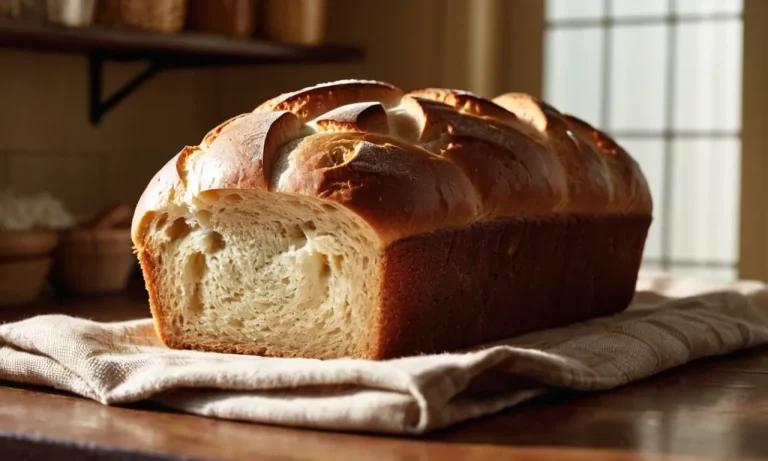Chocolate is more than just a delicious treat – it also holds deep symbolic meaning across cultures and spiritual traditions. Indulging in chocolate can connect us to ideas of luxury, reward, community, and even the divine.
If you’re short on time, here’s a quick answer to what the spiritual meaning of chocolate is: Chocolate symbolizes abundance, pleasure, and even the divine feminine in some cultures. Its rich taste and melt-in-your-mouth texture evoke spirituality.
In this comprehensive guide, we’ll explore the fascinating spiritual symbolism and meaning behind everyone’s favorite confection.
The History of Chocolate and its Spiritual Origins
The Early Mesoamerican Roots of Chocolate
The cacao tree, from which chocolate is made, has its origins in Central America. Archaeologists have found evidence that chocolate was first consumed by pre-Olmec peoples living in the lowland regions of the Mexican Gulf Coast as early as 1750 BC.
Throughout Mesoamerica, chocolate was considered a luxury item and only available to elites. The Maya and Aztec civilizations in particular revered chocolate and used it in sacred rituals.
Chocolate in Mayan and Aztec Belief Systems
For the ancient Maya, cacao was closely linked to fertility and was used in coming-of-age rituals and marriage ceremonies. The Popol Vuh, the sacred text of the Maya, references cacao as an essential element of humanity’s creation.
The Aztecs likewise prized chocolate and often depicted their god Quetzalcoatl giving cacao pods to humans as gifts. Aztec emperor Moctezuma II was said to drink copious amounts of chocolate, believing it invigorated warriors before battle.
Chocolate was also integral to Aztec religious practice. Only elites and sacred religious orders were permitted to consume cacao during rituals. Chocolate drinks were often dyed red and ritually splashed in all four directions to honor the gods of the cardinal points.
Offerings of cacao seeds helped ensure agricultural fertility and the integrity of the state.
The Arrival of Chocolate in Europe
Chocolate was introduced to Europeans in the 16th century following the Spanish conquest of Mexico. Among Catholics, chocolate beverages were at first condemned as sinfully sensual. However, attitudes shifted when the church began baptizing indigenous peoples; soon chocolate was rebranded as a nourishing, medicinal drink compatible with Christian practice.
Its popularity quickly exploded across the continent.
As chocolate’s spiritual roots gave way to secular consumption in the West, new meanings emerged. Chocolate became associated with luxury, gift giving, and expressions of love and affection on holidays like Valentine’s Day.
Yet still today, something of chocolate’s sacred aura lingers in the irresistible delight that it brings.
| Stat | Data |
|---|---|
| Earliest evidence of chocolate consumption | 1750 BC |
| Pre-contact Mesoamericans who used chocolate | Maya, Aztec, others |
To learn more, check out the fascinating history of chocolate at History.com.
Cherished Luxury and Status Symbol
The Rarity and Richness of Chocolate
For much of history, chocolate was an exceptionally rare and prized delicacy, affordable only to the wealthy elite. The cacao tree only grew in limited tropical regions of Central and South America, making cacao beans challenging to obtain for most of the world.
Producing chocolate from raw cacao requires extensive labor – harvesting, fermenting, roasting, and grinding the beans into liquor. This intensive process meant chocolate products commanded extortionate prices.
Royalty and nobles flaunted their privileged status by serving and gifting elaborate chocolate confections at banquets and events. For Europeans of the 17th-19th centuries, the ability to offer chocolate demonstrated affluence and power.
Chocolate consumption represented refinement and luxury outside the means of common folk.
Chocolate for Royalty and the Elite
The Maya and Aztec civilizations prized cacao seeds as divine food. Cacao beans were used as royal currency and offerings to gods. When the Spanish conquered Mexico in the 16th century, they introduced chocolate to Europe’s aristocracy and royal houses.
Spain carefully guarded its chocolate monopoly for over a century. Eventually chocolate spread through the courts of France and England. Louis XIV purportedly imbibed morning cups of chocolate to sustain his amorous escapades.
Chocolate was served exclusively to James II’s nobles at his coronation banquet. Madame du Barry reportedly dispensed advice and chocolate creams to French King Louis XV from her luxurious boudoir.
| 1657 | The first London chocolate shop opens to sell chocolate drink to the elites. |
|---|---|
| 1668 | A Parisian chocolate maker perfects solid eating chocolate suited to French tastes. |
The European upper crust purchased elaborately decorated tea and dinner sets just for the chocolate service. Sterling silver chocolate pots graced the homes of esteemed gentlemen’s clubs and salons hosting intellectual discussions.
For the prosperous bourgeois merchant class, chocolate demonstrated newly acquired status and the ability to access once unobtainable luxuries. Despite chocolate’s growing popularity and availability, it remained a coveted social symbol for those privileged few who could afford its enjoyment.
Symbol of Femininity and Fertility
Links to the Divine Feminine
Throughout history, chocolate has been associated with the sacred feminine and the concept of the Divine Mother. In Aztec mythology, cacao was considered a gift from the goddess of fertility, Xochiquetzal. She was seen as the embodiment of womanhood, symbolizing both motherhood and sensual pleasure.
Images of Xochiquetzal often depict her surrounded by cacao pods, highlighting the integral link between chocolate and the divine feminine.
Even today, chocolate retains connotations of the feminine essence and indulgence in life’s sweetness. Research has uncovered potentially symbolic connections as well – compounds in chocolate named N-acylethanolamines activate pathways in the brain related to relaxation, mood enhancement, and heightened sensitivity, paralleling common descriptions of the divine feminine as loving, soothing, and deeply connected to the flow of life.
Sensuality and Indulgence
Throughout history, chocolate has been seen as an apex food – associated with celebration, luxury, and indulgence of the senses. Even the way chocolate literally melts decadently on one’s tongue mirrors sensations of intimacy and sensual pleasure.
Aztec emperor Montezuma was rumored to drink copious amounts of chocolate before visiting his harem, highlighting how it was seen as an aphrodisiac and sensual symbol even then. Research in the last decade has uncovered scientific mechanisms supporting chocolate’s amorous effects as well.
Compounds like phenylethylamine and serotonin elevate mood and arousal levels, while substances named N-acylethanolamines modulate key brain receptors linked to heightened sensitivity and bliss states.
Given these sensual properties and origins as a courtship gift, it’s symbolic that today chocolate remains a quintessential gift shared between lovers. Over 192 million chocolate treats are estimated to have been purchased last Valentine’s day alone!
So whether luscious melted spoonfuls in ancient Maya ceremonies, steamy Aztec elixirs shared amid fragrant gardens, or modern hand-crafted confections given from the heart, chocolate retains its timeless connotations of pleasure, playfulness, and indulging in life’s deeper connections.
Gift for the Gods and Tool for Worship
Offerings and Rituals
For ancient Mesoamerican civilizations like the Mayans and Aztecs, chocolate was considered a gift from the gods that held deep spiritual meaning. Cacao beans were used in sacred offerings and rituals to honor major deities.
According to archaeological evidence, the Mayans used chocolate drinks in burial rituals, possibly to sustain the spirit in the afterlife.
The Aztecs also offered cacao during sacred ceremonies to gods like Quetzalcoatl, the feathered serpent god. In one major ritual, the Aztecs sacrificed a victim and then gave their heart as an offering to the gods, along with a chalice of chocolate drink.
This reflects how they viewed chocolate as the most precious substance fit for deities.
Spiritual Sustenance
Ancient Mesoamericans also viewed chocolate as a source of spiritual nourishment and life force. The Mayan sacred text Popol Vuh describes cocoa as a vital source of wisdom and knowledge. Cocoa pods symbolized the human heart, and chocolate drinks were used in coming-of-age rituals to transfer spiritual wisdom to young men.
Likewise, Aztec emperor Montezuma II was said to drink staggering 50 cups of chocolate per day to sustain his spiritual and physical stamina. Chocolate was exclusive to royalty and the elite, which further established chocolate’s sacred status in Aztec culture.
So offering chocolate to the Aztec gods was equivalent to sacrificing their most prized possession.
Chocolate Today: More than a Treat
Modern Associations and Symbolism
In the modern era, chocolate has evolved far beyond just a delicious treat. It has taken on rich spiritual meaning and symbolism. Chocolate is often associated with love, pleasure, and indulgence. Giving chocolate, especially on holidays like Valentine’s Day, can represent expressing affection.
It’s a sensory way to say “I care about you” or “I’m thinking of you.”
The sweet, creamy texture and enticing aromas speak to chocolate’s ability to delight multiple senses at once. This multisensory experience evokes a feeling of being nurtured and comforted. The literal “melt-in-your-mouth” quality mirrors the emotional warmth and tenderness associated with chocolate.
It’s no wonder chocolate has become almost synonymous with romance and intimacy.
Beyond love, chocolate can be a symbol of celebration, achievement, or togetherness. Sharing chocolate at gatherings, parties, or milestone events reinforces social bonds. Offering chocolate says “let’s enjoy this moment.”
It represents savoring life’s special occasions and heightens the festive spirit.
A Multisensory Spiritual Experience
Consuming chocolate induces a mild euphoric state by boosting endorphin production in the brain. Endorphins activate the body’s pleasure centers, generating temporary feelings of contentment. This helps explain why chocolate has spiritual connotations of joy and well-being.
Chocolate also contains compounds including theobromine, phenylethylamine, and anandamide that act as mild stimulants or relaxants. By elevating mood, calming stress, or enhancing sociability, chocolate can facilitate a zen-like, peaceful mindset.
Its rich complexity parallels the way spiritual experiences harmonize different emotions.
The ritual of slowly sipping a mug of hot chocolate helps conjure mindfulness. Quiet contemplation allows the drink’s warmth, aroma, and flavor to infuse the senses completely. Blanketing awareness in chocolate’s comforting qualities can feel profoundly grounding.
This immersive sensory process reflects spiritual principles of being fully present.
Here are some examples of how chocolate’s symbolic spirituality manifests in modern culture:
- Exchanging chocolate hearts or roses on Valentine’s Day
- Celebrating special occasions with custom chocolate truffles
- Savoring the meditative experience of chocolate tasting classes
- Using chocolate in sacred ceremonies by ancient Mesoamerican cultures
Conclusion
As we have seen, chocolate holds rich symbolic meaning across history, cultures, and faiths. More than just a food, chocolate continues to represent luxury, sensuality, sustenance, and connection to the divine.
When we mindfully savor chocolate, we carry on this long spiritual heritage – so go ahead, have another bite!
The next time you bite into a luscious piece of chocolate, remember just how spiritually significant this heavenly food has been for centuries. Savor not only the taste, but the whole ritual and experience of chocolate – a multisensory pathway to abundance, pleasure, and the sacred feminine.






